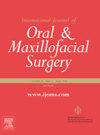上颌和下颌骨新鲜磨牙拔牙槽即刻种植体稳定性的比较:一项对照、前瞻性、非随机临床试验。
IF 2.2
3区 医学
Q2 DENTISTRY, ORAL SURGERY & MEDICINE
International journal of oral and maxillofacial surgery
Pub Date : 2025-01-09
DOI:10.1016/j.ijom.2024.12.011
引用次数: 0
摘要
本研究的目的是评估即刻种植体在新鲜臼齿拔牙槽内的稳定性,并比较那些放置在上颌和下颌骨的种植体。这是一项对照、前瞻性、非随机的临床试验;上颌为试验组,下颌骨为对照组。本研究包括30例需要立即种植的臼齿无法修复的患者。植入手术是使用外科支架和引导手术包进行的。种植体放置后,测量种植体稳定商(ISQ)。植入钛定制愈合基台,并在24周的随访中获得进一步的ISQ值。即刻种植后一期平均稳定性为bbb70(上颌73.98±5.40,下颌骨73.59±6.74);P = 0.864)。在上颌骨,稳定性在2周和4周时下降,然后逐渐增加。总之,在计算机引导下立即在磨牙区放置种植体可以获得良好的种植体稳定性。下颌磨牙区种植体的平均ISQ值高于上颌磨牙区(P = 0.018)。本文章由计算机程序翻译,如有差异,请以英文原文为准。
Comparison of the stability of immediate dental implant placement in fresh molar extraction sockets in the maxilla and mandible: a controlled, prospective, non-randomized clinical trial
The aim of this study was to assess the stability of immediate dental implants in fresh molar extraction sockets and to compare those placed in the maxilla and mandible. This was a controlled, prospective, non-randomized clinical trial; the maxilla was the test group and the mandible was the control group. Thirty patients with an unrestorable molar tooth who needed immediate implant placement were included. The implant surgery was performed using a surgical stent and a guided surgery kit. After placement of the implant, the implant stability quotient (ISQ) was measured. A titanium customized healing abutment was inserted, and further ISQ values were obtained during 24 weeks of follow-up. The mean primary stability after immediate implant placement was >70 (73.98 ± 5.40 in the maxilla and 73.59 ± 6.74 in the mandible; P = 0.864). In the maxilla, stability was reduced at 2 weeks and 4 weeks and then increased gradually. In conclusion, immediate implant placement in the molar region with computer-guided surgery resulted in excellent implant stability. Higher mean ISQ values were obtained for the implants in the mandibular molar region when compared to the maxillary molar region (significant at 24 weeks, P = 0.018).
求助全文
通过发布文献求助,成功后即可免费获取论文全文。
去求助
来源期刊
CiteScore
5.10
自引率
4.20%
发文量
318
审稿时长
78 days
期刊介绍:
The International Journal of Oral & Maxillofacial Surgery is one of the leading journals in oral and maxillofacial surgery in the world. The Journal publishes papers of the highest scientific merit and widest possible scope on work in oral and maxillofacial surgery and supporting specialties.
The Journal is divided into sections, ensuring every aspect of oral and maxillofacial surgery is covered fully through a range of invited review articles, leading clinical and research articles, technical notes, abstracts, case reports and others. The sections include:
• Congenital and craniofacial deformities
• Orthognathic Surgery/Aesthetic facial surgery
• Trauma
• TMJ disorders
• Head and neck oncology
• Reconstructive surgery
• Implantology/Dentoalveolar surgery
• Clinical Pathology
• Oral Medicine
• Research and emerging technologies.

 求助内容:
求助内容: 应助结果提醒方式:
应助结果提醒方式:


